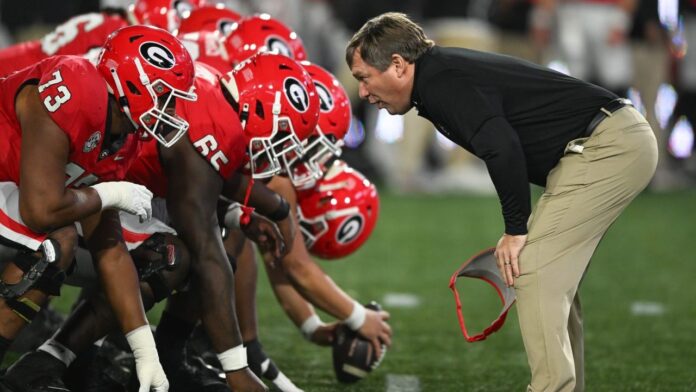Even with the arrival of outside spending by NIL collectives, big-time college athletic departments have continued to allocate more and more of their internal funds toward recruiting.
In fact, according to an analysis of NCAA revenue and expense reports for 91 public Football Bowl Subdivision universities, the cumulative recruiting line-item growth (24%) outpaced that of total athletic department expenditures (13%) from 2021-22 to 2022-23.
The NCAA’s name, image and likeness interim policy went into effect in July 2021.
The recruiting spending spree appears to be consistent throughout FBS: At least seven public Power Five schools reported seven-figure spikes in their recruiting budgets from 2021-22 to 2022-23, while a number of smaller Group of Five programs reported their recruiting costs at least doubling from FY22 to FY23.
Recruiting costs for football, specifically, grew even faster, with a 32% increase from 2021-22 and 2022-23. This should not necessarily be a surprise, given the trend from previous years. While non-football recruiting expenses collectively dipped among these 91 schools from FY19—the last pre-COVID academic year—to FY22, football recruiting costs increased 19%. This, similarly, exceeded the increase in the schools’ overall athletic spending and more than made up for inflation.
The effects of recent deregulation of the NCAA athlete transfer rules were cited as the primary driver for the sharp increase in recruiting expenses, according to athletic department officials who spoke to Sportico. Roster turnover, especially in football, has created a natural increase in travel costs; the idea of booking flights 21 days in advance is now a matter of nostalgia.
“There is a lot more last-minute travel,” LSU associate AD Cody Worsham said. “You are doing a private charter or buying an expensive ticket, rather than (scheduling) a planned-out trip. You are not looking at price, you are looking at immediacy.”
While there might be some cost-savings with recruiting transfer athletes—they might, for example, not desire as extensive (and expensive) recruiting visits—the “sheer volume” of recruiting now more than overwhelms any new efficiencies, Worsham says.
LSU reported spending nearly $4.7 million on recruiting in FY23, which accounted for both university funds and those from the school’s athletic booster organization.
The NCAA Division I Council unveiled its transfer portal in October 2018, ending the controversial practice that required athletes wishing to change schools to first obtain permission from their current institution. Even with the portal, D-I transfers were still required to sit out for one academic year in residence at their new school before being allowed to compete. In the wake of COVID, however, the NCAA amended its rules to automatically allow any athlete the ability to transfer once without having to sit out. The change opened the floodgates: 20,911 D-I college athletes entered the transfer portal in 2022, according to the NCAA’s data, compared to 17,781 portal entrants in 2021.
Where recruiting transfer players was once thought to be beneath the dignity of big-time programs, particularly football, it is now considered essential across the spectrum.
According to data ESPN obtained from SportSource Analytics, more than 20% of FBS football rosters were made up of transfer players in 2023, compared to less than 7% in 2019.
The ensuing frenzy has only added to the existing arms-race mentality around football recruiting.
Georgia—the perennial big spender in athletics recruiting—reported a $7.46 million tab across all sports in 2022-23, with $5.3 million of that attributed to football. By comparison, Georgia spent a little under $4 million total on recruiting in 2017-18. (A school representative declined to comment.)
Outgoing Big 12 member Oklahoma, which will officially join the SEC in July, chalks its increasingly lavish spending up to a desire to match Georgia and its other soon-to-be league rivals. Oklahoma already had one of the largest FBS football recruiting budgets in 2021-22 ($2.6 million), but still increased it by nearly $900,000 for 2022-23.
“As we looked at comparative data related to SEC football program recruiting expenditures, we found that we would need to invest more to compete with the top programs in this area,” Oklahoma athletics spokesperson Michael Houck said.
South Florida deputy AD Kris Pierce, who serves as the Bulls’ sport administrator for football, said that the 140% year-over-year increase in her program’s recruiting expenses reflects, in some part, an effort to compensate for the COVID’s recruiting trail interruptions from 2020 to 2021.
“You couldn’t go out and see people,” Pierce said, “so you (developed) a backlog of trying to get to know these prospects and future student-athletes and this need to get back on the road.”
Last week, The Athletic reported on the advanced plans by the College Commissioners Association’s National Letter of Intent subcommittee to commence the December high-school signing day period before the transfer portal’s winter window opens. Pierce told Sportico that she thinks this could help bring down recruiting costs “a little bit” by giving programs a better sense of their roster needs, before coaches descend upon the talent market.
“The department knew the investment we needed to make for the football program to be successful—that part was no surprise,” Pierce said. “What has come as a surprise for all of us in college football, not just at South Florida, is the rate the transfer portal has impacted (recruiting).”

